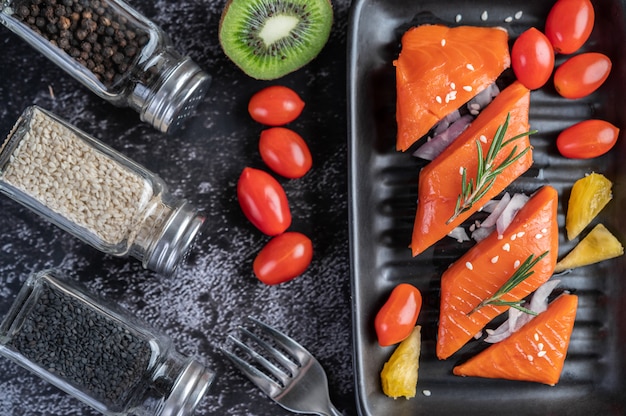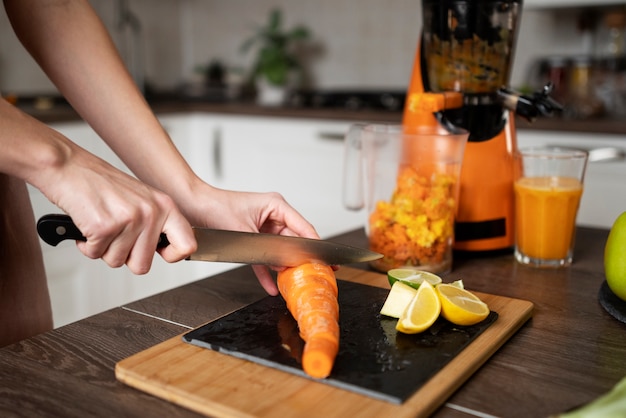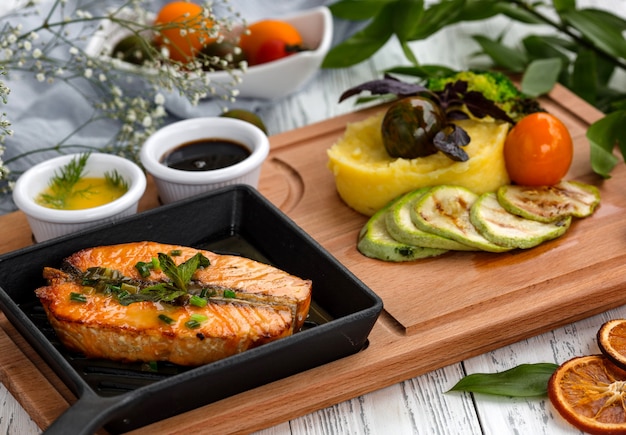Let's be honest, nothing beats a perfectly cooked piece of salmon. Flaky, juicy, and bursting with flavour - it's the ultimate comfort food, especially when you've nailed the cooking temperature. But let's face it, salmon can be a bit tricky. You've got to strike that delicate balance - avoiding dry, overcooked fish while ensuring it's safely cooked through.
Don't worry, I'm here to guide you through the whole process, sharing my own experiences and tips. We'll explore different cooking methods, learn how to tell if your salmon is cooked just right, and even tackle those pesky Fahrenheit and Celsius conversions. Get ready to become a salmon-cooking superstar!
(Part 1) Setting the Stage: Getting to Know Your Salmon

Before we dive into the world of temperature, let's take a moment to understand our star ingredient. Salmon isn't just salmon, you know. There are different types, each with its own unique personality that affects how it cooks.
Different Salmon, Different Cooking
Think about it like this: atlantic salmon, the most common type, is like the lean, athletic friend who needs a little extra care to stay hydrated. pacific salmon, like sockeye and Chinook, are the more robust types, packed with flavour and fat, so they can handle a little more heat.
Fresh or Frozen?
And then there's the question of fresh versus frozen. Fresh is always best, but let's be real, frozen salmon is a lifesaver when you're short on time. Just make sure you thaw it properly, whether it's overnight in the fridge or using the defrost setting on your microwave. Remember, avoid overcooking once it's thawed.
(Part 2) Temperature Talk: Understanding the Basics

Now, let's get down to the nitty-gritty – temperature! It's the key to a perfectly cooked salmon, but don't panic, it's not as complicated as it seems. The magic number we're aiming for is the internal temperature, which is the temperature of the fish's core. It tells us if the salmon is cooked through without being overdone.
Degrees Fahrenheit vs. Celsius
Hold on, before we delve into specific temperatures, let's clear up the whole Fahrenheit and Celsius thing. You might see temperatures quoted in both, which can be confusing. The golden standard for cooked salmon is 145 degrees Fahrenheit (that's 63 degrees Celsius). This ensures the fish is cooked through but still retains its delicious moistness.
The Importance of a meat thermometer
Now, how do we know if our salmon is at that perfect temperature? That's where a trusty meat thermometer comes in handy. This little gadget is a lifesaver, especially when it comes to salmon. It takes the guesswork out of cooking, allowing you to accurately measure the internal temperature and ensure that your fish is cooked perfectly every time.
(Part 3) Cooking Methods: Exploring the Options

Alright, we've got the basics down – now it's time to explore the different ways we can cook our salmon. Each method has its own advantages and flavour profiles.
1. Pan-Seared salmon: The Classic
Pan-searing is the classic way to cook salmon. It results in that beautiful, crispy brown exterior and a delicate, flaky interior. Here's the key: you need a hot pan, medium-high heat. A little oil, and you're ready to go. Gently place your salmon skin-side down, giving it some space to cook evenly.
Here's a little trick to test if your pan is hot enough: drop a drop of water into the pan. If it sizzles immediately, you're good to go! Cook for about 3-4 minutes per side, or until the internal temperature reaches that magic 145 degrees F (63 degrees C). The skin should be crisp and the flesh should be opaque, with a slightly firmer texture.
2. baked salmon: Easy and Foolproof
If you're looking for a super easy and fuss-free option, baking is your go-to method. Preheat your oven to 375 degrees F (190 degrees C), line a baking sheet with parchment paper, and season your salmon with salt, pepper, and any other spices you fancy. Slide it onto the baking sheet and bake for 12-15 minutes, or until that thermometer tells you it's reached 145 degrees F (63 degrees C).
You can even create a one-pan meal by tossing in some vegetables like broccoli, asparagus, or zucchini. Another tip: wrap your salmon in foil with some herbs and a splash of lemon juice for a delicious, steamy experience.
3. grilled salmon: A Taste of Summer
Grilling salmon is a perfect way to celebrate the warmer months. Preheat your grill to medium heat, brush the grates with oil, and season your salmon with your favourite spices. Place it on the grill and cook for about 4-5 minutes per side, or until that trusty thermometer hits 145 degrees F (63 degrees C).
Want to take it up a notch? Try grilling your salmon over cedar planks. The cedarwood adds a beautiful smoky aroma and flavour to the fish. Just soak the planks in water for at least 30 minutes before grilling.
4. poached salmon: Gentle and Delicious
Poaching salmon is a gentler approach, resulting in a tender, flaky fish. Bring a pot of water to a simmer, add a few slices of lemon, a bay leaf, and some peppercorns. Gently place your salmon in the water and simmer for about 10-12 minutes, or until the internal temperature reaches 145 degrees F (63 degrees C).
Poaching is ideal if you're looking for a light and healthy meal. Serve it with a creamy dill sauce or a vibrant salad.
(Part 4) Timing is Everything: Avoiding overcooked salmon
So, we know about temperatures, but how do we know when our salmon is cooked perfectly? The key is to avoid overcooking, but at the same time, we don't want to eat it raw, right?
Visual Clues: Look for Flaky Fish
Here's the thing: a cooked salmon's flesh should be opaque, not translucent. It should also flake easily with a fork. If it feels firm and doesn't flake, it's probably overcooked.
Don't Be Afraid to Test
Another trick: use your finger! Gently press the thickest part of the salmon. If it springs back, it's cooked. If it feels soft or mushy, it needs a little more time.
Give It a Rest
Once your salmon is cooked, don't rush to serve it. Let it rest for a few minutes before slicing. This allows the juices to redistribute, making for a more flavourful and moist fish.
(Part 5) Salmon Cooking Temperatures: A Handy Chart
To summarise all those cooking temperatures, here's a handy chart for quick reference:
| Cooking Method | Internal Temperature (F) | Internal Temperature (C) |
|---|---|---|
| Pan-Seared | 145 degrees | 63 degrees |
| Baked | 145 degrees | 63 degrees |
| Grilled | 145 degrees | 63 degrees |
| Poached | 145 degrees | 63 degrees |
(Part 6) Salmon Serving Ideas: Delicious Possibilities
Now that your salmon is cooked to perfection, it's time to think about how to serve it. The possibilities are endless, so let's explore some delicious options.
Classic Combinations
For a classic, you can't go wrong with lemon and dill. The bright acidity of lemon cuts through the richness of the salmon, while dill adds a fresh, herbaceous aroma. You can also serve your salmon with a simple sauce made with butter, lemon juice, and chopped dill.
Spicy and Savory
Feeling adventurous? Try a spicy and savory combination. Sriracha mayo, chipotle sauce, or even a drizzle of hot honey can add a kick to your salmon. Serve it with a side of roasted vegetables or a crunchy salad.
Light and Fresh
For a lighter meal, pair your salmon with a fresh salad or a simple side of roasted vegetables. A drizzle of olive oil and a squeeze of lemon juice will enhance the natural flavour of the salmon.
(Part 7) Beyond the Basics: Exploring Flavors
We've covered cooking techniques and temperatures, but what about flavour? It's time to get creative and explore the world of salmon seasonings.
Spiced Salmon: A World of Flavors
Adding spices to your salmon is a simple way to elevate its flavour profile. You can use pre-made spice blends or create your own concoctions. A simple mix of salt, pepper, paprika, and garlic powder is always a good starting point.
For a more adventurous flavour profile, try a blend of cumin, coriander, and turmeric. You can also add a pinch of smoked paprika for a smoky flavour.
Herbs and Citrus: Aromatic Delights
Herbs and citrus can add a fresh, aromatic touch to your salmon. Try a combination of dill, parsley, and lemon zest for a classic flavour. You can also use other herbs like thyme, rosemary, or basil.
Glazes and Marinades: Intense Flavors
Glazes and marinades can add a layer of flavour and moisture to your salmon. A simple honey-soy glaze is a delicious option, and you can also use a marinade made with olive oil, lemon juice, and herbs.
(Part 8) salmon mistakes to Avoid: Lessons Learned
We've all been there, haven't we? Those moments when our salmon didn't quite turn out as planned. It's all part of the learning process. Here are some common mistakes to avoid, based on my own experience:
1. Overcrowding the Pan
When pan-searing salmon, make sure you don't overcrowd the pan. Give the fish plenty of space to cook evenly. If you overcrowd the pan, the salmon will steam instead of sear, resulting in a less appealing texture.
2. Not Patting Dry
Always pat your salmon dry before cooking. Excess moisture will prevent the skin from crisping up properly.
3. Flipping Too Soon
Don't flip your salmon too soon! Let it cook for a few minutes on one side before flipping. You want to create a nice, crispy crust.
4. Ignoring the Internal Temperature
Don't rely solely on visual cues to judge the doneness of your salmon. Always use a meat thermometer to ensure it reaches the correct internal temperature.
5. Overcooking
Overcooked salmon is dry, tough, and unappealing. Use the visual cues and the meat thermometer to ensure your salmon is cooked perfectly.
(Part 9) FAQs: Addressing Your Salmon Queries
1. Can I eat raw salmon?
While sushi-grade salmon is safe to eat raw, it's not recommended to eat raw salmon unless you are certain it has been properly prepared and frozen to kill any parasites. It's always best to cook salmon thoroughly to ensure food safety.
2. Can I freeze salmon?
Yes, you can freeze salmon. To freeze salmon, wrap it tightly in plastic wrap or aluminum foil, and then place it in a freezer-safe bag. Frozen salmon can be stored for up to 3 months.
3. How do I know if salmon is bad?
Fresh salmon should have a bright, red colour and a firm texture. It should also have a mild, fishy smell. If your salmon has a strong fishy smell, a slimy texture, or a dull colour, it's probably bad.
4. What's the best way to cook salmon for a crowd?
For a crowd, baking is a great option. It's easy to cook multiple pieces of salmon at once, and it's also a very forgiving cooking method.
5. Can I reheat cooked salmon?
Yes, you can reheat cooked salmon. The best way to reheat salmon is in the oven or microwave. To reheat in the oven, preheat your oven to 350 degrees F (175 degrees C) and place the salmon on a baking sheet. Heat for about 10 minutes, or until warmed through. To reheat in the microwave, place the salmon on a microwave-safe plate and heat for 30-60 seconds, or until warmed through.
Everyone is watching

Corn on the Cob: The Ultimate Guide to Perfectly Cooked Ears
Healthy MealsAh, corn on the cob. Just the name evokes images of sunny days, barbecues, and that sweet, juicy flavour that ...

Perfect Pork Roast Oven Cooking Time: A Guide to Delicious Results
Healthy MealsThere's something truly satisfying about a perfectly roasted pork. The aroma alone is enough to make your mout...

Ham Cooking Time: How Long to Bake, Smoke, or Boil a Delicious Ham
Healthy MealsAh, ham. It's a classic, isn't it? A real crowd-pleaser, especially around holidays. And when done right, it'...

Scallops: The Ultimate Guide to Perfect Cooking
Healthy MealsAh, scallops. Those delicate, sweet, and utterly delicious morsels of the sea. They hold a special place in my...

Spaghetti Squash: The Ultimate Guide to Cooking and Serving
Healthy MealsRemember that time you saw spaghetti squash at the supermarket, looking all bumpy and strange, and thought, "W...
